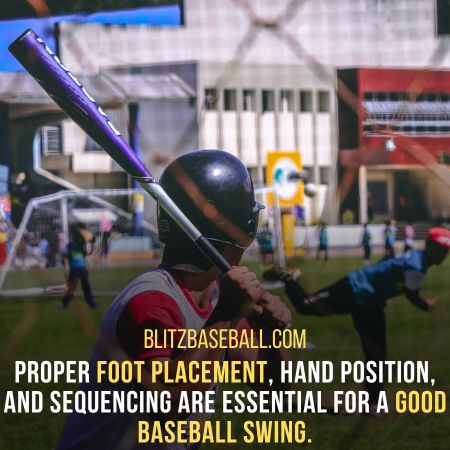Baseball, a sport beloved by many, requires a fundamental skill: swinging a baseball bat correctly. Mastering this technique is crucial for success in the game.
In this informative article, we will explore how to swing a baseball bat provided by a knowledgeable coach to learn the proper technique for swinging a baseball bat.
From foot placement to hand position, from upper body readiness to sequencing, every aspect of a good swing will be covered in detail.
The article will emphasize the importance of eye and hand coordination, load control, and correct launch position. Additionally, it will offer drills to improve swing mechanics and address common swing flaws that players may encounter.
The article will also guide players in selecting the appropriate bat length based on their weight, and recommending wooden bats for beginners.
By following these easy steps, players will be well on their way to mastering the art of swinging a baseball bat correctly and enhancing their overall performance on the field.
Key Takeaways
- Proper foot placement, hand position, and sequencing are essential for a good baseball swing.
- Generating power requires proper rotation of the hips and torso, as well as a still head and controlled follow-through.
- Hand-eye coordination is crucial for tracking the pitch and timing the swing.
- Incorporating drills to improve hand-eye coordination and address swing flaws can lead to a more effective and powerful swing.
Proper Batting Techniques: How To Swing A Baseball Bat?
Proper batting techniques in baseball involve understanding the mechanics of a good swing, including foot placement, hand position, and maintaining proper sequence and coordination.
One crucial aspect of a proper swing is the bat grip. It is essential to grip the bat firmly but not too tightly, allowing for proper bat control and generating power.
The hands should be positioned comfortably on the bat, with the top hand slightly higher than the bottom hand.

As the swing begins, the feet should be properly positioned, with the front foot slightly open and the back foot slightly closed. This foot placement allows for better balance and weight transfer during the swing.
Additionally, generating power in a swing requires proper rotation of the hips and torso, along with a still head and a controlled follow-through.
By understanding and implementing these techniques, players can improve their batting skills and enhance their front elbow swing.
Swing Mechanics and Sequencing
Sequencing and mechanics play a vital role in achieving an effective and powerful baseball swing. Proper sequencing ensures that the body moves in the correct order, maximizing power and generating a smooth swing.
It begins with the lower body, where the importance of hip rotation cannot be overstated. The rotation of the hips generates torque and transfers energy from the lower body to the upper body, resulting in a powerful swing.
Hand-eye coordination is also crucial in the swing. The batter must track the pitch with their eyes and time their swing accordingly. The hands must be in sync with the body, allowing for quick and precise movements.
Developing these skills through practice and repetition will lead to a consistent and successful baseball swing.

Common Swing Flaws and Drills
One common flaw in the mechanics of a baseball swing is the failure to maintain a still head throughout the swing. When a hitter’s head moves excessively during the swing, it can lead to poor balance, reduced hand-eye coordination, and inconsistent contact with the ball.
To fix this swing flaw and improve hand-eye coordination, there are several drills that can be utilized:
-
Head stability drill: This drill involves focusing on keeping the head still while taking swings. Hitters can use a mirror or have a coach provide feedback to ensure their head remains in a fixed position.
-
Balance drill: Balancing on one foot while taking swings helps develop stability and control, forcing the hitter to focus on maintaining a still head.
-
Eye tracking drill: Using a tennis ball or small object, hitters can practice tracking the ball with their eyes, helping to improve hand-eye coordination and reduce head movement.
-
Soft toss drill: By using soft toss, hitters can focus on keeping their head still while making contact with the ball, reinforcing proper mechanics and hand-eye coordination.

By incorporating these drills into their practice routine, players can work towards fixing swing flaws and improving their hand-eye coordination for a more effective baseball swing.
Frequently Asked Questions
What is the ideal weight for a baseball bat?
The ideal weight for a baseball bat can vary depending on the player’s strength and swing mechanics. However, lighter baseball bats generally allow for faster swing speeds, which can result in increased power and bat control.
How can I improve my bat speed?
To improve bat speed, it is important to have a proper grip on the baseball bat, which allows for maximum control and power. Additionally, hip rotation plays a crucial role in generating a faster swing. To improve hip rotation, focus on exercises that strengthen the core and rotational movements.
Are there any specific exercises or drills to improve my hand-eye coordination for batting?
Video games can help improve hand-eye coordination for batting by requiring players to react quickly to visual stimuli. Vision training, such as tracking moving objects on a screen, can also enhance hand-eye coordination for batting by improving visual processing and reaction time.
Should I use a different swing technique for different types of pitches?
To hold the baseball bat correctly for different pitch types, it is important to have a proper grip. Adjusting swing technique to different pitch speeds and locations requires good timing and plate discipline.
How can I adjust my swing to hit for more power?
To adjust your swing for more power, focus on adjusting your swing mechanics. This can be done by incorporating proper hip rotation, which generates more power and allows for increased bat speed and distance on contact with the ball.
